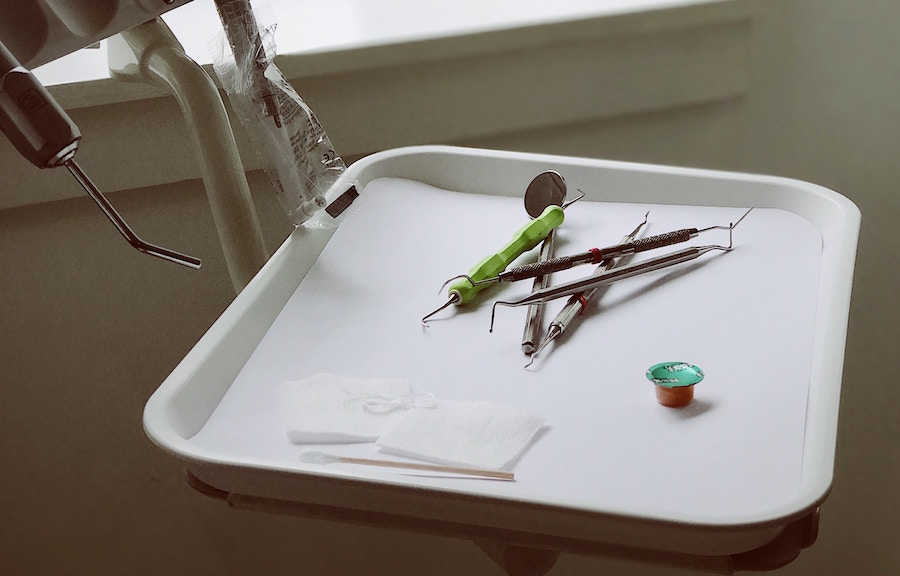Plaque is basically the bane of your mouth’s existence. This sticky film can accumulate on your teeth and lead to issues like cavities and sore, puffy gums. Is a water flosser the best way to prevent grody plaque from building up between your teeth?
Blasting your teeth with an appliance that would fit right in at the dentist’s office seems like a good idea in theory, but you might be wondering if there’s any point in buying a water flosser when you can use regular ol’ string floss.
Just like string floss, a water flosser cleans between your teeth.
Removing little bits of gunk from your teeth is super important. When you allow food and drink particles to stew in your mouth, the resulting plaque releases acids that harm your enamel (the tough external portion of your teeth), according to the American Dental Association (ADA). These acids can eventually drill cavities into your teeth and cause gingivitis, the first stage of gum disease. Brushing your teeth twice a day helps you scrub away plaque so that it can’t hurt your teeth or gums. So does flossing, which can make sure you reach the little nooks and crannies a toothbrush neglects. You’re probably pretty familiar with string floss, of course, but water flossers are also an option. A water flosser is a handheld device that shoots a stream of liquid at your teeth hard enough to clean between them. You can call them powered interdental cleaners if you want to be posh about it. Some versions even allow you to use a mixture of water and mouthwash for an extra fresh experience.A water flosser might be good for you depending on your teeth and preferences.
Using a water flosser is like hosing down a deck while traditional flossing is like sweeping it. They both get the job done, albeit in slightly different ways. Use whichever one makes you less likely to pretend flossing is a concept you’ve never heard of before. Here are signs a water flosser might be good for you:- You’re not diligent about using the correct flossing technique with string, so you could be leaving a lot of food behind. Shoving the string into each crevice, yanking it out, and moving on doesn’t cut it. You’re supposed to insert the floss, then use a C shape to scrape the string down both teeth, one after the other. You’re also supposed to floss the back sides of your last teeth, FYI. If you’d rather do your taxes than follow these steps, a water flosser might be better for you.
- You have dental or orthodontic work that makes it tricky to floss traditionally, like braces or a permanent retainer of some sort.
- Your teeth aren’t super straight. If you have trouble running floss back and forth between them, a water flosser could make your life easier.
- You hate traditional flossing. Perhaps you’re not a fan of extracting chewed up bits of food from your mouth. Maybe every time you do it, you wonder if you have 357 teeth because getting between them all takes forever.

 Having chronic gum disease gives people a 70% increased risk of developing Alzheimer's, scientists have found.
Research has linked gum problems and dementia for several years. These studies have usually been small in which a snapshot of people's health in time has been taken, rather than large studies tracking their likelihood of developing disease in the long term.
One of the largest longitudinal studies on the topic has now found a strong correlation between gum disease, or periodontitis, and risk of Alzheimer's. The
Having chronic gum disease gives people a 70% increased risk of developing Alzheimer's, scientists have found.
Research has linked gum problems and dementia for several years. These studies have usually been small in which a snapshot of people's health in time has been taken, rather than large studies tracking their likelihood of developing disease in the long term.
One of the largest longitudinal studies on the topic has now found a strong correlation between gum disease, or periodontitis, and risk of Alzheimer's. The  image via Unsplash[/caption]
There's nothing like jamming a waxed piece of string between your tightest molars and sliding it back and forth. And who doesn't do that once a day, just as the dentist prescribes?
Well, a lot of us. Twenty-seven percent of adults lie to their dentists about how often they floss their teeth, a
image via Unsplash[/caption]
There's nothing like jamming a waxed piece of string between your tightest molars and sliding it back and forth. And who doesn't do that once a day, just as the dentist prescribes?
Well, a lot of us. Twenty-seven percent of adults lie to their dentists about how often they floss their teeth, a  Gingivitis is one of the
Gingivitis is one of the 
 As far as my dental history goes, I've been pretty lucky. My parents always stressed the importance of taking care of my teeth and took me to the dentist on a regular basis. I never had to have braces and didn't even have a cavity for most of my 30s.
Then, as they say, "go big or go home": at 39, I had my first cavity. I didn't even know I had one until my tooth chipped over dinner. An immediate trip to the dentist revealed I not only had a cavity, but I would need a root canal and then a crown. I made it through both those things and thought it was over. I swore to myself I would do a better at staying on top of things and went on with my life.
From the day the crown was placed, it never felt "right": there was always an element of discomfort and my 24/7 awareness that it felt foreign and weird. After the first year, I started feeling more discomfort. Around year two, I began to notice gum inflammation around the crown. Unfortunately, the dentist who did the crown work had gone out of business, so I had to find a new dentist. Many of my downtown/east Nashville friends had recommended Downtown Dental.
Dr. Clark and his team were amazing from my first patient exam. Turns out I not only had a metal allergy to the original crown, but the deep placement of the crown had created significant gum infection. It wasn't the worst news, but as someone who is highly sensitive to antibiotics and tries to go the natural route whenever possible, I didn't look forward to the treatment that would clear up the infection/irritation. Enter "the laser".
I soon happily learned that dentists can use lasers for a host of incredible treatments: not only for bacterial reduction (in this case, for my gums), but for pain management/anesthesia, fillings, tooth contouring/cleaning, and even cold sores. My three laser treatments were quick, absolutely painless, and best of all, I didn't have to take any antibiotics.
The team at Downtown Dental is warm and wonderful, but even better than that, I'm thankful for a dentist who commits to painless technology as treatment versus standard pharmaceutical medication. Turns out there's a better way to do a lot of things without wreaking havoc on the body...even in dentistry.
-D. Carson, 41: Dickson, TN
As far as my dental history goes, I've been pretty lucky. My parents always stressed the importance of taking care of my teeth and took me to the dentist on a regular basis. I never had to have braces and didn't even have a cavity for most of my 30s.
Then, as they say, "go big or go home": at 39, I had my first cavity. I didn't even know I had one until my tooth chipped over dinner. An immediate trip to the dentist revealed I not only had a cavity, but I would need a root canal and then a crown. I made it through both those things and thought it was over. I swore to myself I would do a better at staying on top of things and went on with my life.
From the day the crown was placed, it never felt "right": there was always an element of discomfort and my 24/7 awareness that it felt foreign and weird. After the first year, I started feeling more discomfort. Around year two, I began to notice gum inflammation around the crown. Unfortunately, the dentist who did the crown work had gone out of business, so I had to find a new dentist. Many of my downtown/east Nashville friends had recommended Downtown Dental.
Dr. Clark and his team were amazing from my first patient exam. Turns out I not only had a metal allergy to the original crown, but the deep placement of the crown had created significant gum infection. It wasn't the worst news, but as someone who is highly sensitive to antibiotics and tries to go the natural route whenever possible, I didn't look forward to the treatment that would clear up the infection/irritation. Enter "the laser".
I soon happily learned that dentists can use lasers for a host of incredible treatments: not only for bacterial reduction (in this case, for my gums), but for pain management/anesthesia, fillings, tooth contouring/cleaning, and even cold sores. My three laser treatments were quick, absolutely painless, and best of all, I didn't have to take any antibiotics.
The team at Downtown Dental is warm and wonderful, but even better than that, I'm thankful for a dentist who commits to painless technology as treatment versus standard pharmaceutical medication. Turns out there's a better way to do a lot of things without wreaking havoc on the body...even in dentistry.
-D. Carson, 41: Dickson, TN
 Though the link between dental health and heart health is not completely clear, experts say it’s important to take care of both.
Claiming around 610,000 lives each year, heart disease is the No. 1 killer of both men and women in the U.S.1 Did you know that research has found a link between this deadly disease and the health of your gums?
Having gum disease increases the risk of a first heart attack by 28%, according to a 2016 study by the Karolinska University Hospital in Sweden.2
“Although the findings indicate a strong link between gum disease and heart disease, it’s still unclear whether one actually causes the other,” says the American Heart Association. The two conditions have some of the same risk factors, including smoking, poor nutrition and diabetes. Researchers believe that inflammation caused by periodontal disease may be responsible for the connection.3
Though the link between dental health and heart health is not completely clear, experts say it’s important to take care of both.
Claiming around 610,000 lives each year, heart disease is the No. 1 killer of both men and women in the U.S.1 Did you know that research has found a link between this deadly disease and the health of your gums?
Having gum disease increases the risk of a first heart attack by 28%, according to a 2016 study by the Karolinska University Hospital in Sweden.2
“Although the findings indicate a strong link between gum disease and heart disease, it’s still unclear whether one actually causes the other,” says the American Heart Association. The two conditions have some of the same risk factors, including smoking, poor nutrition and diabetes. Researchers believe that inflammation caused by periodontal disease may be responsible for the connection.3